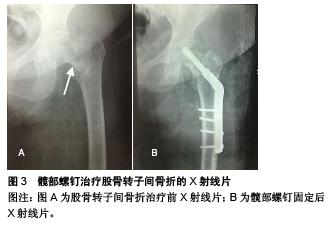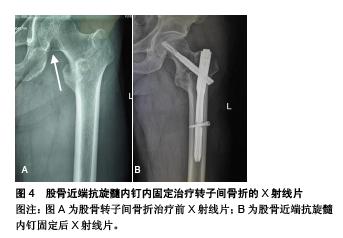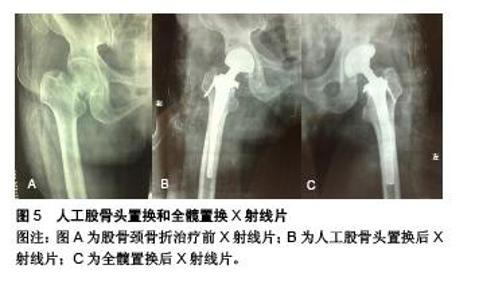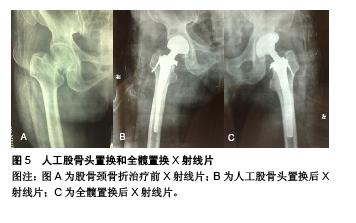Chinese Journal of Tissue Engineering Research ›› 2015, Vol. 19 ›› Issue (48): 7811-7818.doi: 10.3969/j.issn.2095-4344.2015.48.018
Previous Articles Next Articles
The choice of hip fracture implants and their complications
Wang Xin
- Department of Orthopedics, Tianjin Port Hospital, Tianjin 300456, China
-
Received:2015-11-03Online:2015-11-26Published:2015-11-26
CLC Number:
Cite this article
Wang Xin. The choice of hip fracture implants and their complications[J]. Chinese Journal of Tissue Engineering Research, 2015, 19(48): 7811-7818.
share this article
| [1] 曹琴.循证护理在老年髋部骨折护理中的应用[J].微量元素与健康研究,2015,32(2):70-71.
[2] Buecking B, Bohl K, Eschbach D,et al. Factors influencing the progress of mobilization in hip fracture patients during the early postsurgical period?-A prospective observational study. Arch Gerontol Geriatr. 2015;60(3):457-463.
[3] 王振恒,方永超,阚翔翔,等.影响老年髋部骨折患者术后1年死亡率的因素分析[J].中国矫形外科杂志,2014,22(2):110-114.
[4] Palm H, Posner E, Ahler-Toftehøj HU, et al. High reliability of an algorithm for choice of implants in hip fracture patients. Int Orthop. 2013; 37(6):1121-1126.
[5] 王伟,单明忠.空心加压螺钉内固定治疗股骨颈骨折疗效分析[J].航空航天医学杂志,2014,25(11):1550-1551.
[6] 朱刚劲,马锦鹏,曹树泽. DHS治疗股骨粗隆间骨折疗效分析[J]. 中外医学研究,2014,12(5):150-151.
[7] 戴海,黎裕明,吴永祥. DHS、DCS、PFN治疗股骨粗隆间骨折疗效对比分析[J]. 现代诊断与治疗,2012,23(6):644-646.
[8] 童安,王建伟,赵毅. DHS和PFN内固定治疗股骨粗隆间骨折临床疗效和安全性探讨[J]. 河北医学,2013,19(9): 1380-1382.
[9] 满达.人工股骨头置换与全髋关节置换治疗老年股骨颈骨折临床疗效对比[J]. 实用临床医药杂志,2014,18(7): 41-43.
[10] Shiga T, Wajima Z, Ohe Y. Is operative delay associated with increased mortality of hip fracture patients? Systematic review, meta-analysis, and meta-regression. Can J Anaesth. 2008; 55(3): 146-154.
[11] Griffiths R, Alper J, Beckingsale A, et al. Management of proximal femoral fractures 2011: Association of Anaesthetists of Great Britain and Ireland. Anaesthesia. 2012;67(1): 85-98.
[12] Maxwell L, White S. Anaesthetic management of patients with hip fractures: an update. Critical Care Pain. 2013;13(5): 179-183.
[13] Hartmann B, Junger A, Klasen J, et al. The incidence and risk factors for hypotension after spinal anesthesia induction: an analysis with automated data collection. Anesth Analg. 2002; 94(6): 1521-159.
[14] Khanna G, Cernovsy J. Bone cement and the implications for anaesthesia. Anaesthesia Critical Care Pain. 2012;12(4); 213-216.
[15] 方洪松,甘经岳,彭昊.股骨颈骨折空心加压螺钉内固定失败后的再手术治疗[J].中国骨与关节损伤杂志,2012,27(2):136-137.
[16] 扎西罗布,落松群培,廖涛.高原地区动力髋螺钉内固定术治疗中青年股骨颈骨折的研究[J]. 西藏医药,2014,35(4):4-6.
[17] 章年年,叶招明,朱仰义.双螺钉系统与3枚空心加压螺钉治疗股骨颈骨折的比较研究[J]. 中国骨伤,2013,26(7):565-571.
[18] 张绍安,郑水长,魏新军.双头螺纹空心加压螺钉治疗股骨颈骨折临床分析[J].2013,35(9):1359-1360.
[19] 李慧勇.经皮加压螺钉内固定治疗老年股骨粗隆间骨折疗效分析[J].中国医学创新,2010,7(11):166-167.
[20] 郭金刚,郭金城,赵勇,等.动力髋螺钉治疗股骨粗隆间骨折并发症原因分析及防治[J].中国骨伤,2008,21(5):341-342.
[21] 张杰敏,黄素碧,陈柯,等.高龄股骨粗隆间骨折病人人工半髋关节置换术后切口感染的护理[J]. 护理研究,2014,28(5): 1867-1868.
[22] 付建,顾华,易难,等.股骨近端股骨钉治疗股骨粗隆间骨折38例[J].现代医药卫生,2008,24(15):2265-2266.
[23] 郭金刚,郭金城,赵勇,等.动力髋螺钉治疗股骨粗隆间骨折并发症原因分析及防治[J].中国骨伤,2008,21(5):341-342.
[24] 赖苑威,张根民.股骨粗隆间骨折内固定并发症原因分析[J]. 中国修复重建外科杂志,2009,23(1):120-122.
[25] 陆晴友,彭庄,祝建光,等. 股骨近端可膨胀髓内钉治疗股骨粗隆间骨折及相关并发症的防治[J].中国矫形外科杂志, 2009,17(4): 248-251.
[26] 崔长权,陈必波. 股骨近端重建髓内钉内固定治疗股骨粗隆间骨折[J].中国医学创新,2012,9(26):103-105.
[27] 张杰敏,黄素碧,陈柯,等. 高龄股骨粗隆间骨折病人人工半髋关节置换术后切口感染的护理[J]. 护理研究,2014,28(5): 1867-1868.
[28] 彭铁钢.人工股骨头置换术治疗老年人股骨颈骨折及并发症的处理[J].中国医疗前沿,2013,8(21):42转16.
[29] 杨喜旺,朱振军,程田. 60例(64髋)人工股骨头置换手术并发症的分析和预防[J].中国医药指南,2009,7(10):92-93.
[30] 丁鑫.人工股骨头置换临床疗效及并发症分析[J].中外医学研究,2013,11(10):104.
[31] 范庆旺,闫树君,李春雨,等.人工股骨头置换治疗老年股骨粗隆间骨折并发症的预防[J]. 河北医学,2010,16(3):270-272.
[32] 李尚仲,李艳,闫新峰.人工髋关节置换术治疗老年股骨颈骨折的疗效及术后并发症原因探讨[J].中国临床研究,2015,28(8): 1038-1039.
[33] 李想,陈玉兰,顿丽亚.人工全髋关节置换术后并发症的预防护理[J].中国实用神经疾病杂志,2012,15(2):92-93.
[34] 倪丹.髋关节置换术后并发症的预防及护理[J].临床合理用药杂志,2014,7(11):156-157.
[35] 胡兴录,税毅冬,赵高.人工全髋关节置换术后常见并发症的护理[J].临床合理用药杂志,2012,5(10B):145-146.
[36] 贺明,王佳时,王广斌.人工全髋关节置换术235例早期并发症分析[J]. 中国误诊学杂志,2011,11(35):8705.
[37] 朱文梅.人工全髋关节置换术18例并发症预防及护理体会[J].实用医技杂志,2011,18(7):773-774.
[38] 徐晓丽.人工全髋关节置换术围手术期护理及并发症预防.哈尔滨医药,2011,31(6):472-473.
[39] Buecking B, Wack C, Oberkircher L, et al. Do concomitant fractures with hip fractures influence complication rate and functional outcome? Clin Orthop Relat Res. 2012;470(12): 3596-3606.
[40] Blomfeldt R, Törnkvist H, Ponzer S, et al. Comparison of internal fixation with total hip replacement for displaced femoral neck fractures. Randomized, controlled trial performed at four years. J Bone Joint Surg Am. 2005;87(8): 1680-1688.
[41] Lu-Yao GL, Keller RB, Littenberg B, et al. Outcomes after displaced fractures of the femoral neck. A meta-analysis of one hundred and six published reports. J Bone Joint Surg Am. 1994;76(1): 15-25.
[42] Issack PS, Barker J, Baker M, et al. Surgical management of metastatic disease of the proximal part of the femur. J Bone Joint Surg Am. 2014;96(24):2091-2098.
[43] Jain R, Koo M, Kreder HJ, et al. Comparison of early and delayed fixation of subcapital hip fractures in patients sixty years of age or less. J Bone Joint Surg Am. 2002;84-A(9): 1605-1612.
[44] Rodríguez-Merchán EC. Displaced intracapsular hip fractures: hemiarthroplasty or total arthroplasty? Clin Orthop Relat Res. 2002;(399): 72-77.
[45] Weisová D, Salášek M, Pavelka T. Hip fractures. Cas Lek Cesk. 2013;152(5):219-225.
[46] Kim WY, Han CH, Park JI, et al. Failure of intertrochanteric fracture fixation with a dynamic hip screw in relation to pre-operative fracture stability and osteoporosis. Int Orthop. 2001;25(6): 360-362.
[47] Baumgaertner MR, Curtin SL, Lindskog DM, et al. The value of the tip-apex distance in predicting failure of fixation of peritrochanteric fractures of the hip. J Bone Joint Surg Am. 1995;77(7): 1058-1064.
[48] Thein E, De Cannière A, Burn A, et al. Medial migration of lag screw after gamma nailing. Injury. 2014;45(8):1275-1279.
[49] Prokop A, Dolezych R, Chmielnicki M. Pertrochanteric fracture - operation for beginners? Z Orthop Unfall. 2014; 152(6):584-587.
[50] Sadowski C, Lübbeke A, Saudan M, et al. Treatment of reverse oblique and transverse intertrochanteric fractures with use of an intramedullary nail or a 95 degrees screw-plate: a prospective, randomized study. J Bone Joint Surg Am. 2002;84-A(3): 372-381.
[51] Okcu G, Ozkayin N, Okta C, et al. Which implant is better for treating reverse obliquity fractures of the proximal femur: a standard or long nail? Clin Orthop Relat Res. 2013;471(9): 2768-2775.
[52] 李佛保,盛璞义,韩士英,等.人工股骨头置换与全髋关节置换术治疗股骨颈骨折[J].中华骨科杂志,1999,19(3):152-154. |
| [1] | Chen Ziyang, Pu Rui, Deng Shuang, Yuan Lingyan. Regulatory effect of exosomes on exercise-mediated insulin resistance diseases [J]. Chinese Journal of Tissue Engineering Research, 2021, 25(25): 4089-4094. |
| [2] | Chen Yang, Huang Denggao, Gao Yuanhui, Wang Shunlan, Cao Hui, Zheng Linlin, He Haowei, Luo Siqin, Xiao Jingchuan, Zhang Yingai, Zhang Shufang. Low-intensity pulsed ultrasound promotes the proliferation and adhesion of human adipose-derived mesenchymal stem cells [J]. Chinese Journal of Tissue Engineering Research, 2021, 25(25): 3949-3955. |
| [3] | Yang Junhui, Luo Jinli, Yuan Xiaoping. Effects of human growth hormone on proliferation and osteogenic differentiation of human periodontal ligament stem cells [J]. Chinese Journal of Tissue Engineering Research, 2021, 25(25): 3956-3961. |
| [4] | Sun Jianwei, Yang Xinming, Zhang Ying. Effect of montelukast combined with bone marrow mesenchymal stem cell transplantation on spinal cord injury in rat models [J]. Chinese Journal of Tissue Engineering Research, 2021, 25(25): 3962-3969. |
| [5] | Gao Shan, Huang Dongjing, Hong Haiman, Jia Jingqiao, Meng Fei. Comparison on the curative effect of human placenta-derived mesenchymal stem cells and induced islet-like cells in gestational diabetes mellitus rats [J]. Chinese Journal of Tissue Engineering Research, 2021, 25(25): 3981-3987. |
| [6] | Hao Xiaona, Zhang Yingjie, Li Yuyun, Xu Tao. Bone marrow mesenchymal stem cells overexpressing prolyl oligopeptidase on the repair of liver fibrosis in rat models [J]. Chinese Journal of Tissue Engineering Research, 2021, 25(25): 3988-3993. |
| [7] | Liu Jianyou, Jia Zhongwei, Niu Jiawei, Cao Xinjie, Zhang Dong, Wei Jie. A new method for measuring the anteversion angle of the femoral neck by constructing the three-dimensional digital model of the femur [J]. Chinese Journal of Tissue Engineering Research, 2021, 25(24): 3779-3783. |
| [8] | Meng Lingjie, Qian Hui, Sheng Xiaolei, Lu Jianfeng, Huang Jianping, Qi Liangang, Liu Zongbao. Application of three-dimensional printing technology combined with bone cement in minimally invasive treatment of the collapsed Sanders III type of calcaneal fractures [J]. Chinese Journal of Tissue Engineering Research, 2021, 25(24): 3784-3789. |
| [9] | Qian Xuankun, Huang Hefei, Wu Chengcong, Liu Keting, Ou Hua, Zhang Jinpeng, Ren Jing, Wan Jianshan. Computer-assisted navigation combined with minimally invasive transforaminal lumbar interbody fusion for lumbar spondylolisthesis [J]. Chinese Journal of Tissue Engineering Research, 2021, 25(24): 3790-3795. |
| [10] | Hu Jing, Xiang Yang, Ye Chuan, Han Ziji. Three-dimensional printing assisted screw placement and freehand pedicle screw fixation in the treatment of thoracolumbar fractures: 1-year follow-up [J]. Chinese Journal of Tissue Engineering Research, 2021, 25(24): 3804-3809. |
| [11] | Shu Qihang, Liao Yijia, Xue Jingbo, Yan Yiguo, Wang Cheng. Three-dimensional finite element analysis of a new three-dimensional printed porous fusion cage for cervical vertebra [J]. Chinese Journal of Tissue Engineering Research, 2021, 25(24): 3810-3815. |
| [12] | Wang Yihan, Li Yang, Zhang Ling, Zhang Rui, Xu Ruida, Han Xiaofeng, Cheng Guangqi, Wang Weil. Application of three-dimensional visualization technology for digital orthopedics in the reduction and fixation of intertrochanteric fracture [J]. Chinese Journal of Tissue Engineering Research, 2021, 25(24): 3816-3820. |
| [13] | Sun Maji, Wang Qiuan, Zhang Xingchen, Guo Chong, Yuan Feng, Guo Kaijin. Development and biomechanical analysis of a new anterior cervical pedicle screw fixation system [J]. Chinese Journal of Tissue Engineering Research, 2021, 25(24): 3821-3825. |
| [14] | Lin Wang, Wang Yingying, Guo Weizhong, Yuan Cuihua, Xu Shenggui, Zhang Shenshen, Lin Chengshou. Adopting expanded lateral approach to enhance the mechanical stability and knee function for treating posterolateral column fracture of tibial plateau [J]. Chinese Journal of Tissue Engineering Research, 2021, 25(24): 3826-3827. |
| [15] | Zhu Yun, Chen Yu, Qiu Hao, Liu Dun, Jin Guorong, Chen Shimou, Weng Zheng. Finite element analysis for treatment of osteoporotic femoral fracture with far cortical locking screw [J]. Chinese Journal of Tissue Engineering Research, 2021, 25(24): 3832-3837. |
| Viewed | ||||||
|
Full text |
|
|||||
|
Abstract |
|
|||||







